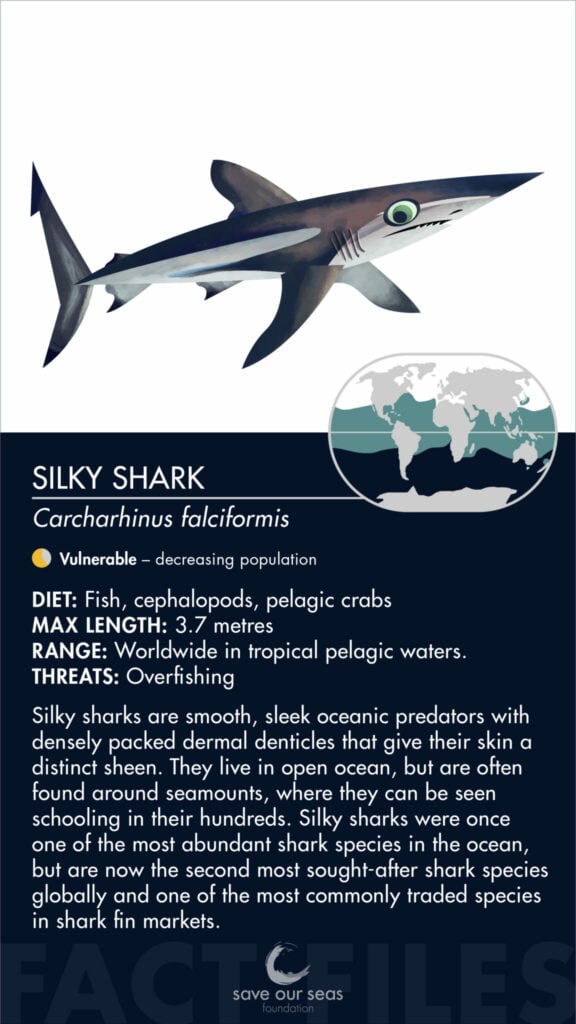Silky shark
Carcharhinus falciformis



Silky sharks are smooth, sleek oceanic predators with densely packed dermal denticles that give their skin a distinct sheen. They live in the open ocean but are often found around seamounts, where schooling in their hundreds can be seen. Silky sharks were once one of the most abundant shark species in the ocean but are now the second most sought-after shark species globally and one of the most commonly traded species in shark fin markets.
Identification
At first, silky sharks can seem difficult to identify as they lack clearly distinguishing markings. They are large and slender with a grey/bronze colour and are often mistaken for Galapagos sharks. The easiest way to recognise silky sharks and tell these two species apart is by their first dorsal fin – silky sharks have a sloped dorsal fin with quite a rounded tip, whereas Galapagos sharks have a steep dorsal fin with a pointed tip and straight rear edge. The second dorsal of a silky shark also has a very long trailing edge that can be twice the length of the fin height. The denticles of silky sharks are very tightly packed and overlap, giving their skin a smooth sheen and texture.

Special behaviour
Silky sharks are highly social and curious animals. At certain locations, such as Cocos in Costa Rica, silky sharks can be seen aggregating in schools of several hundred, just like scalloped hammerhead sharks. They are also a very bold species of shark, like the oceanic whitetip, and will readily investigate most objects in their environment.
Reproduction
Silky sharks are viviparous, meaning they produce live young that are nourished internally using a placenta. After a gestation period of 9 to 12 months females will have 2 to 18 pups per litter. Silky sharks take 5 to 15 years to mature, and may have litters annually, or every other year, depending on their location.
Habitat & geographical range
Silky sharks have a worldwide distribution in tropical waters. While they can be found in oceanic waters, they are most commonly encountered near the edge of continental and insular shelves in waters shallower than 200 m. Juveniles tend to be found coastally, with adults more in open water. Silky sharks are often associated with items that drift at the surface, and also follow schools of tuna.

Diet description
Silky sharks display a reasonably diverse diet that mainly includes bony fish (e.g. tuna, mullet, mackerel) and cephalopods (e.g. squid), but can also feature crustaceans such as pelagic crabs.
Threats
Silky sharks are primarily threatened by overfishing and, after the blue shark, are the second most commonly caught shark in global fisheries. They are easily taken in both longline and purse seine fisheries and are typically retained for their meat and fins. They are particularly vulnerable to purse seine fisheries that use fish aggregating devices (FADs) – large floating objects that attract fish – as silky sharks often associate with them. Silky sharks also represent the third most common species of shark in the fin markets of Hong Kong. Intense sustained fishing pressure on silky sharks has caused estimated population declines of 47 to 54% globally, but in some regions (e.g. southeast Pacific) these declines may exceed 90%. Given such severe declines, the silky shark is considered vulnerable on the IUCN Red List and has been listed on Appendix II of CITES, restricting its international trade.
Relationship with humans
The main relationship silky sharks have with people is as a resource. As one of the most commonly caught shark species, they are a significant source of meat and other products, including their fins, liver oil and skin for leather.
However, they are also highly curious sharks and are of increasing interest to ecotour operators in a variety of locations, especially deep water close to shore. In the Red Sea and offshore sites in the Pacific (e.g. Galapagos, Cocos, Revillagigedo) they are regularly encountered and favoured by photographers due to their curiosity and close approaches. They can also be seen schooling in their hundreds in Malpelo off Colombia.
Fun facts
Silky shark skin has more densely packed denticles than most other sharks, giving them a more silky-smooth appearance and texture.
They are highly social and often seen in large groups, in some locations (e.g. Malpelo, Colombia) forming schools of hundreds of individuals that rival the iconic scalloped hammerhead shark.
They have a particularly good sense of hearing, which they use alongside their other senses to track down large aggregations of feeding tuna. If there’s lots of noise, there’s usually lots of fish to eat.
References
David A. Ebert. et al, 2021, Sharks of the World: A Complete Guide.
IUCN Red List of Threatened Species, Silky shark: Carcharhinus falciformis
Florida Museum, 2018, Carcharhinus falciformis





